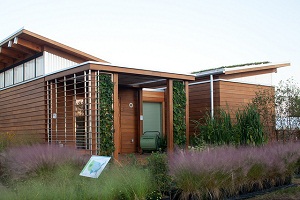A closer look at Solar Decathlon winner Watershed House
 They usually say “Three’s a charm,” but for the University of Maryland (UMD), it turned out to be the fourth was a charm—at least in terms of the Department of Energy’s Solar Decathlon. The University of Maryland’s WaterShed house won this year’s Solar Decathlon, with its highly efficient home inspired by the water issues that plague the Chesapeake Watershed.
They usually say “Three’s a charm,” but for the University of Maryland (UMD), it turned out to be the fourth was a charm—at least in terms of the Department of Energy’s Solar Decathlon. The University of Maryland’s WaterShed house won this year’s Solar Decathlon, with its highly efficient home inspired by the water issues that plague the Chesapeake Watershed.
The house maintained the lead throughout the most of the Solar Decathlon’s 10 contests, winning three of the Decathlon’s contests, architecture, energy balance and hot water.
In addition to building a solar-powered house, the team placed careful emphasis on how water was used by the house and its inhabitants.
“WaterShed was more than just a university project, it was intended to influence the direction of the industry at large into a more environmentally friendly way of building,” said Amy Gardner, an associate professor at UMD’s School of Architecture, Planning & Preservation, and director of its Center for the Use of Sustainable Practices.
The focus on water is important, particularly in the Chesapeake Watershed, which remains polluted with failing fisheries despite more than 20 years of conservation efforts. To mitigate the WaterShed house’s impact on the region, all the grey water produced by the home—including rainwater, shower, washer and dishwater, and sink water—is reused onsite through the home’s plant-based filtration system, reducing the need for irrigation.
“We are thrilled with the way in which WaterShed was received by the public and by the jurors alike,” Gardener said. “We are gratified that the testing and practice that was performed prior to the competition allowed for a successful operation of the house in the measured contests.”
While it’s hard to compare past events directly with this one, schools have been building better houses for the competition.
“Over the past three decathlons, teams and their houses have generally greatly improved on the measured contests and tasks,” Gardener said, making the award that much more prestigious this time around.
The event also seemed busier than in previous years, according to Gardener.
“Foot traffic was great. I think this decathlon, foot traffic met or exceeded the previous one in 2009,” she said. “For our house, we had over 20,000 visitors over the course of Sept. 23 to Oct. 2.”
What will happen to the house next isn’t yet known.
“The university is working on possibilities for the final home for WaterShed,” Gardener said. “Wherever WaterShed ends up, I hope it continues to show that implementing these types of green technologies and design can be easy, affordable, comfortable and beautiful.”



